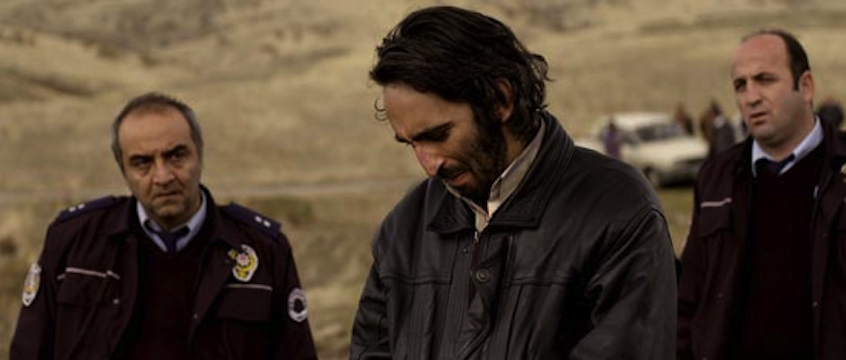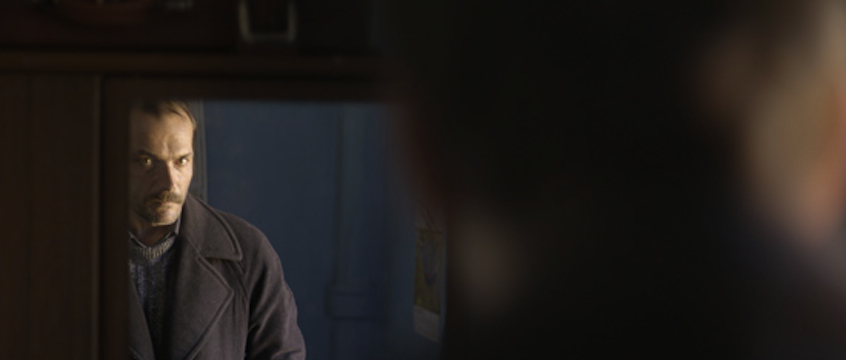Once Upon a Time in Anatolia. Directed by Nuri Bilge Ceylan. Turkey, 2011.
Nuri Bilge Ceylan’s Once Upon a Time in Anatolia opens with a scene in which the truth is buried; it is there in front of us but hidden. The first thing we see is an image that is shot from outside a dirty window. The camera remains outside, but the faces behind the window slowly become visible: three men are having drinks inside a car-mechanic`s workshop. We are left outside, the sound is distant, and the image is blurry. A truck passes by and wipes the image out. This was it; that is when it happened. Shortly after this scene, we learn that one of those men was killed by one of the other two. The following image is darkness in an open field: a ball of fire is coming towards us, one that burns the screen. Ever experienced being hypnotized while watching the flames? That is the fire approaching.
Co-winner of the Grand Prix award at the Cannes Film Festival this year (sharing the award with Dardenne Brothers’ Le Gamin au Vélo), Once Upon a Time is a witty and poetic film, and possibly Ceylan’s best yet. In addition to his breathtaking imagery and poetic sequences, the film has an immaculate sound design. It is also bolder and braver than his previous films, both aesthetically and narratively. This bold attitude extends to his casting choices as well, where one name in particular stands out: Yılmaz Erdoğan, who plays the police chief in the film. Casting Erdoğan, who is an established filmmaker and a huge comedy star in Turkey, seemed like a brave move for Ceylan, but a worrying one as well. Considering Erdoğan’s popularity in the country, his presence ran the risk of overtaking the film. However, within the first ten minutes, this fear proves to be unfounded. Every single performance, including Erdoğan’s, is no less than brilliant.
The plot is simple: a murder takes place in a remote town in Anatolia and an investigation is underway. Loosely based on a true story, the film unfolds over a long night, going into the early hours of the next day, in a small town in the Kırıkkale province. The prosecutor, Nusret (Taner Birsel); the doctor, Cemal (Muhammet Uzuner); the police chief, Naci (Yılmaz Erdoğan); the driver, nicknamed Arap (Ahmet Mümtaz Taylan); the police officer, İzzet (Murat Kılıç); and the murder suspects, Kenan (Fırat Tanış) and his brother Ramazan (Burhan Yıldız), along with a few others, are traveling in three vehicles to locate the body of a young man (Erol Eraslan) who has been murdered. Kenan has apparently confessed to the murder and told the police that he can show them where he buried the body. But ironically, he fails to do so the first few times and is unable to find the exact location. “These places all look similar,” he says, adding that he had too much to drink that day and that the darkness does not help.
As the three cars travel, there are flashes of lightning, momentarily highlighting an aspect in each character’s life, the scars they acquired, the pain they inflicted: the remains of the past do not remain in the past. It is during this journey that one of the most poetic scenes in the film takes place: an apple falls from a tree and the camera follows its journey. The apple, unhurriedly, rolls down, drops into the stream, and after a short journey in the water, joins other apples that apparently have been through the exact same journey, but are now rotting. Time in this scene becomes almost tactile. Death is inevitable, and life seems to be flowing, but what about everything else in between? The lies, the heartbreaks, the suppression, the ugliness? Why does even a mundane conversation about buffalo yogurt become a power struggle?

[Still image from "Once Upon a Time in Anatolia."]
Many critics writing about the film have commented about its length: spreading over 157 minutes, the film is undoubtedly long. In a question and answer session after the film’s screening at the London Film Festival this year, Ceylan said that he wanted his audience to be bored a little, like his characters were. I can safely say that he failed in that task. During this long gaze over a small town you are left with yourself—that is, you watch the film as yourself, since the director does not provide any of the mechanisms that would allow the audience to identify with one of the characters. Now, to be left alone with yourself for 157 minutes is very long for the faint-minded, for most of us in fact. But Ceylan’s visual poetry, along with his affectionate attention to the mundane details of life, takes you on a journey.
Boredom is not necessarily the right word to describe this type of storytelling, at least not in the usual sense of the word, as used in order to describe uninteresting or unworthy activities/experiences. Perhaps it is the kind of boredom that Walter Benjamin defined as “the apogee of mental relaxation.” Boredom, he said, is “the dream bird that hatches the egg of experience.” Benjamin writes these words in relation to a particular (and rapidly disappearing) mode of storytelling and listening. In the same paragraph, he also says that in that relaxed state the listener (or in our case, the viewer) also needs to forget him/herself in order for the story to become memorable, to be turned into an experience. This might seem to contradict what I just said about being left with yourself; however, it is the self that goes through that experience and, hence, the self continues to be present. What is important here, I believe, is the rhythm of the self, which is replaced by the rhythm of the story. This is not an easy task, but it is one that Ceylan succeeds in achieving.
On the other hand, to those familiar with his work, a murder mystery might at first appear to be an odd addition to Ceylan’s filmography. However, it seems to me that he finally found a way to do what he wanted to do in his 2002 film Distant, also awarded the Grand Prix at Cannes. Ceylan, when talking about Distant, described shooting a scene where the two main characters kill a neighbor and become partners in crime and guilt. But he later decided to cut the scene out, as he feared it would become the central story, something that he did not want. In Once Upon A Time in Anatolia, the murder is the center of the story, but this, ironically, gives him a narrative space to gaze over the “side” stories. It is not a coincidence that Ceylan’s official web site contains the following in lieu of a synopsis of the film: “Life in a small town is akin to journeying in the middle of the steppes: the sense that ‘something new and different’ will spring up behind every hill, but always unerringly similar, tapering, vanishing or lingering monotonous roads...” This is pretty much what the film is about.
As the characters drive through the vast open fields of Anatolia with no buildings in sight, the land appears timeless, and coupled with Ceylan’s use of space as well as his obsession with time, every single frame turns into a poetic utterance. However, the timeless appearance of the land does not mean it lacks time; rather, it compresses time in a different way. The journey, and the long takes of those vehicles approaching in darkness, appearing like balls of fire, almost unzips the land, what the land enfolds, transforming the space into (an aoristic) time.
This is a film about life and death, the ghosts of the past, the search for the truth, but perhaps more importantly, about power relations. In this respect it is very similar to Ceylan’s previous film Three Monkeys (2008), where he also dealt with secrets and ghosts and ways of exerting power over others. In Three Monkeys, the characters were running away from the truth. In Once Upon a Time in Anatolia it appears, at first, that the characters are searching for the truth, but what they are chasing are the facts of the matter. However, facts do not necessarily lead them (or us) to the truth. On the contrary, as long as they are good enough facts to narrate a story about an event (in this case a murder), the truth remains veiled, buried, possibly buried alive. It is in the characters’ journey (the experience) to collect facts (as well as apples and melons and stories), which takes up an entire night, that the truth becomes visible to the senses. It is the experience, both the characters` as well as the audience`s, that later becomes the truth.
When the corpse is finally found, we witness another detail of how the state apparatus works: it is what they say happened (in particular the prosecutor and the doctor) that will remain on the “documents.” However, what they say happened is not necessarily what did happen: it is only having the authority to utter those words that makes them facts. The external examination of the body is done without touching it; questions are answered without being asked; and statements are written without witnesses ever talking. One can not help but imagine these documents being read in the future, as the only accounts of what happened. The events will be judged based on these official documents. The facts spelled out in these reports will overwrite the truth. These official documents, and the obsession with them when it comes to narrating the “truth,” resonate on many different levels with Turkey’s recent history, particularly when thought together with the title. The story does not take place in the past (once upon a time). It takes place now, in the present.
Although the film is a journey into the dark emotional and material landscape, it is one that does not lack humor. On the contrary, the film is full of funny moments. One of the most memorable of these takes place towards the end: as the prosecutor is dictating his report to his assistant at the scene where the body is found, he jokes about the victim’s resemblance to Clark Gable. The conversation, as he was expecting, turns quickly into how, in fact, he himself resembles Gable, to which he responds by brushing his moustache. These men share a moment of joy and laughter, which momentarily brings them equality. However, it is also an uncanny image: laughter by the side of a corpse. Life really is beautiful and ugly, funny and sad at the same time.
At the end of the film, the doctor, performing the autopsy (or rather, supervising the autopsy, as he never really touches the corpse), spells out the facts of the matter for the official report: “no abnormalities were found,” despite the evidence suggesting that the victim was buried alive. Why? That is left for us to think about. In this respect, Anton Chekov (for whom Ceylan has repeatedly declared his admiration) is not only present in quotations inserted in the dialogues, but also in Ceylan’s interest in asking questions (and his disinterest in answering them). Sometimes, the truth is seen only when reflected, like our own faces, always with us but not always visible to us.

[Still image from "Once Upon a Time in Anatolia."]
![[Still image from \"Once Upon a Time in Anatolia\"]](https://kms.jadaliyya.com/Images/357x383xo/still13.jpg)






